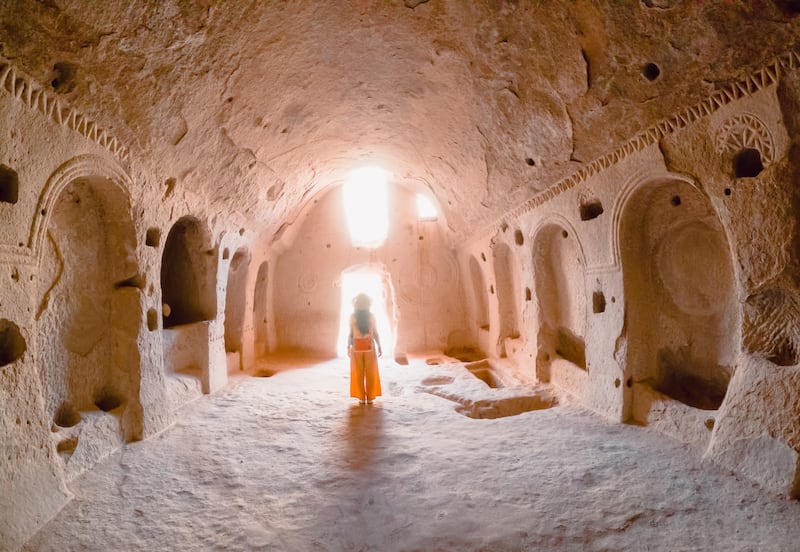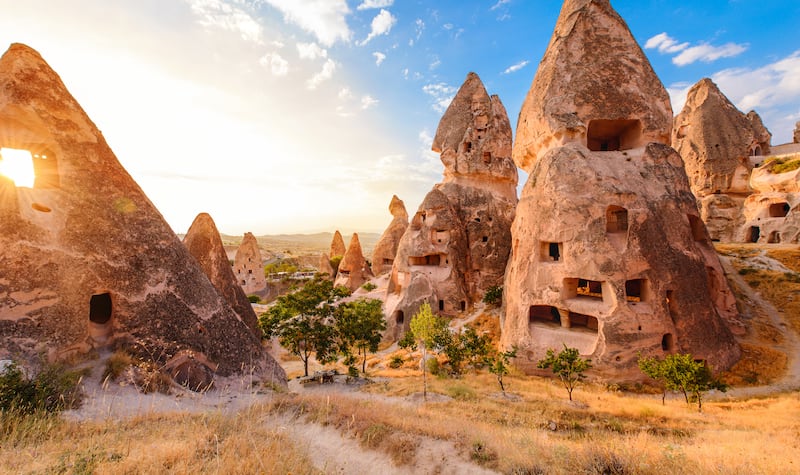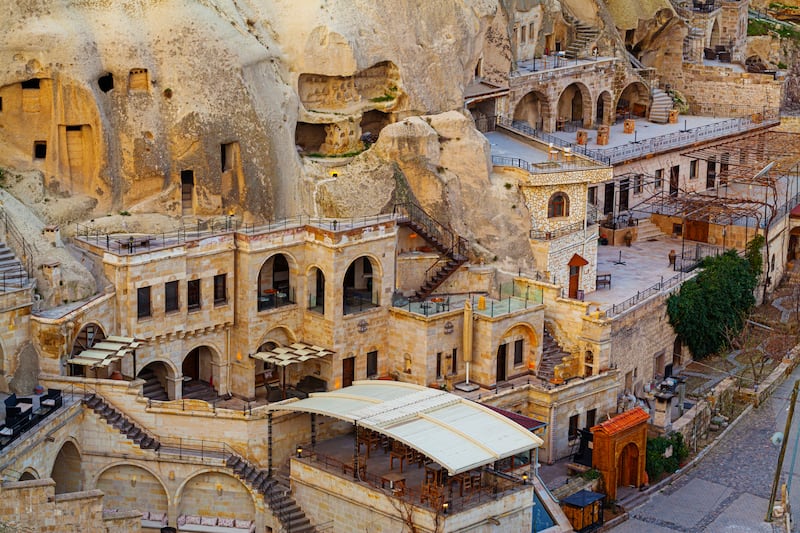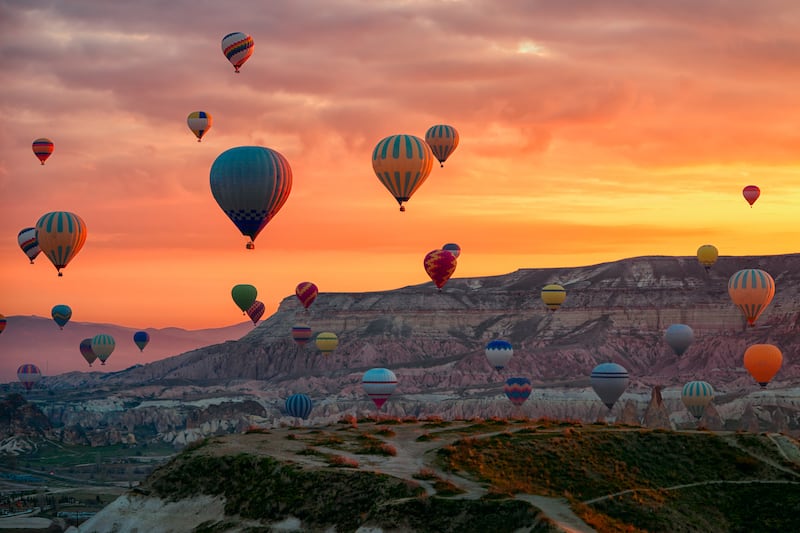It is 4.30am in the Goreme Valley in Cappadocia, Turkey and I am part of a bleary-eyed group heading out for a trip on a hot-air balloon to see the sunrise. When we arrive at the field and witness the 18m-high balloons, their colossal size comes as a surprise, as do the noise and reach of the gas flares as they inflate, illuminating the darkness.
It is a little overwhelming and scary as we climb into the wicker baskets, each of the six sections holding four people. Slowly, under the guidance of our pilot, we lift off for the flight, one of more than 100 that morning. We are cautioned about the landing procedure. Balloons fly up to 3,000ft (about 900m) above ground level. Fatalities are rare, but two Spanish tourists died in 2022 on a hard landing.
This central region of Turkey, Anatolia, is famous for its otherworldly volcanic rock formations and cone-shaped fairy chimneys that host caves, churches, pigeon houses and ancient subterranean dwellings that stretch across 400km of high plateau. To view this extraordinary landscape from the air makes the trip magical. We skim these chimney tops, look down on small gardens, valleys, fields and roadways. Beneath us cars, trucks and horses look like dinky toys. Anatolia, we are told, means a place where the sun rises. It is also famous for its horses. Moonlight horse trekking is said to be another enchanting experience. And the sunset is, of course, wondrous.

There are many other aspects of Cappadocia (pronounced Cappa Dockia) to discover on this design-and-art trip organised by the Istanbul Designers Iconic group in association with Go Turkey. Founded by two women, Serra Arikok and Asli Valier Pelit, they bring together and promote Turkish designers and artists. Our group includes young Turkish milliner Muge Bozkurt of hatmaker.co, who trained with the royal milliner Rose Cory in London, and the celebrated textile artist, designer, dancer and choreographer Firat Neziroglu. As a dancer he worked with Martha Graham in New York, and as a craftsman was commissioned by both the queen of Thailand and Queen Elizabeth to weave their portraits.
One of our first stops is to the Cappadocia Art and Culture Centre, a non-profit organisation founded by veteran Istanbul fashion star Simay Bulbul, who is known for stylish embellished leather and evening wear, and her husband Serhan Saripinar, an architect with a love of art and antiques. The couple bought an old cave hotel in one of the chimneys 15 years ago and transformed it into an open-air gallery and exhibition centre. Having started with 17 artists, they now have 30.

Arriving in the courtyard we are greeted by a massive bull and rhinoceros composed of oxidised iron panels by Berlin based Turkish artist Huseyin Arda, a huge metal geodesic structure by the Italian artist Angelo Loconte, and other sculptures alongside antique entrance doors and pillars collected by the couple. The labyrinthine cavernous interior, a warren of rooms, houses other artworks, an art library and a space for residential workshops, as well as a mobile display of Simay’s dresses. “When stones from sealed entrances are removed, we keep discovering new rooms and then we have to call archaeologists,” Simay explains. Views from the terrace are breathtaking.
Pottery and ceramics have thousands of years of history in the region, used for storage, cooking and winemaking. In Avanos, we watch a potter in action at a famous fifth-generation workshop, Omurlu Seramik, and marvel at the sheer scale of what they can produce, from small cups and saucers to huge wall hangings and mosaics, including display plates that glow in the dark. Clay pots are still used for cooking; earlier in the day at the Yunak Cave Hotel, the chef displayed how a local Anatolian specialty, a casserole dish called lamb testi or “pottery kebab”, is cooked. The lamb is prepared with vegetables in clay pots sealed with dough, left to simmer for hours in their juices and then cracked open under fire using a cleaver and a fireproof glove. It is quite thrilling to watch.

The beautiful Christian cave churches are also worth visiting, monastic sites dating from the 4th to 11th centuries. These strange conical formations were the results of volcanic eruptions millions of years ago. Over time, wind rain and other forces of nature eroded the rock creating a soft tufa stone that could be carved into cave dwellings. Early Christians fled persecution from the Romans in these caves, where there are underground cities as well as chapels and monastic cells. In one, called the Dark Church, the frescoed walls depicting scenes from the New Testament and Christ the Pantocrator are the best preserved in the region. It was used as a pigeon house until the 1950s, and took 14 years to restore.
Other memorable experiences include taking part in an old Anatolian shamanic ritual at an almond tree, tasting an impressive variety of organically grown local wines from a boutique winery called Gulor founded in 1993 by Turkish businesswoman and philanthropist Gulor Sabanci, breathtaking views and menus at restaurants Revitha and Lila (where we encounter lavender-flavoured butter for the first time), the valleys at Devrent, Zelve and Pasabag with their surreal landscapes, and Pigeon Valley, where thousands of pigeon houses are carved into the rock.

But the finale of the trip is probably the most spectacular of all, an event staged once a year at the Yunak Hotel. Arriving at the courtyard at night to retire to our cave dwellings, we are faced to our astonishment by an enormous hot-air balloon in full flight mode along with special lighting and music. It is like a bizarre rock concert, and for a trip that had begun and ended with a balloon, an unforgettable farewell.
Get there
To get to Cappadocia, there are connecting flights from Dublin with Turkish Airlines and Pegasus from Istanbul to Kayseri, the local airport. From there it is a 45-minute drive to Goreme and to Urgup, the village where we stayed.
This trip took place before an attack on a Catholic church in Istanbul on January 28th, for which the Islamic State group has claimed responsibility. The Department of Foreign Affairs advises travellers to “exercise a high degree of caution”. Check dfa.ie for up-to-date travel advice.


















